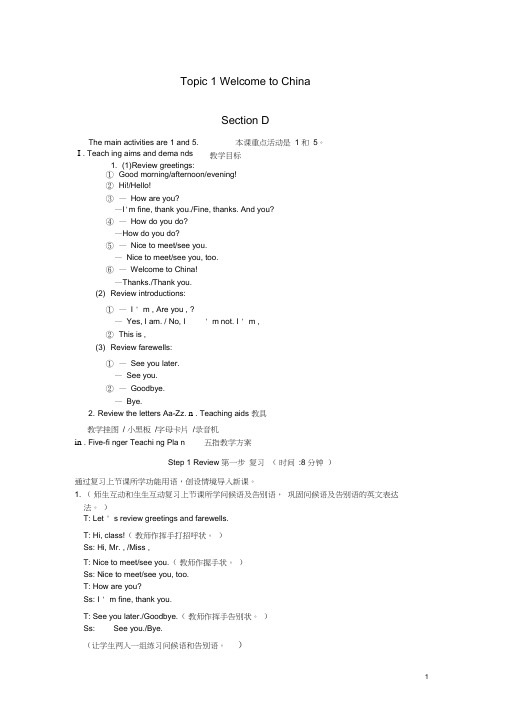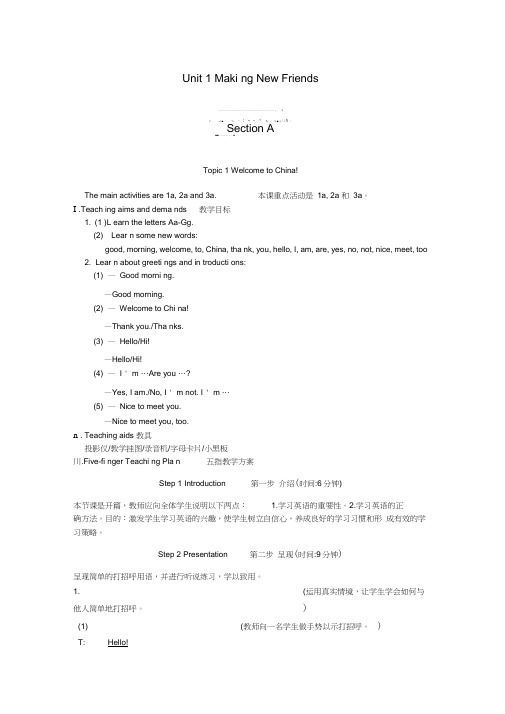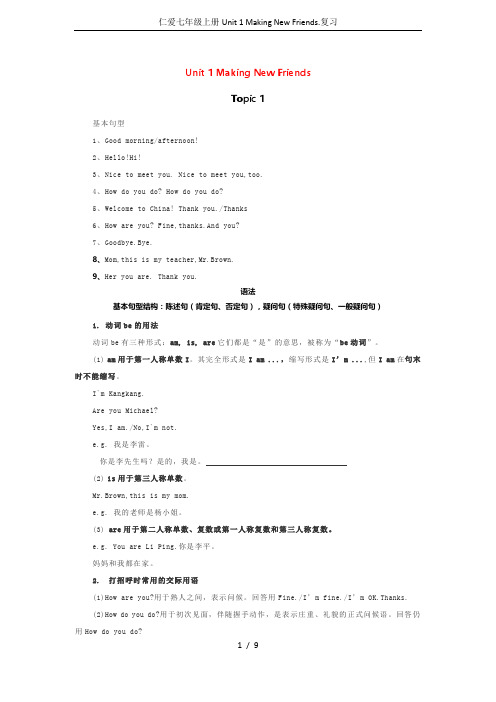七年级英语上册《Unit 1 Making new friends Topic 2 Where are you from Section A》导学案(1)
- 格式:doc
- 大小:104.00 KB
- 文档页数:2

《Unit 1 Making new friends Topic 1 Welcome to China SectionB》学习目标:教学过程:一、自主学习1.预习课本P4 3a,按笔画顺序熟练写出Hh- Nn7个字母。
---------------------------------------------------------------------------------------------------------------------------------------------------------------------------------------------------------------------------------------------------------------------------------------------------------------------------------------------------------------------------------------------------------------------------------------------------------------------------------------- 2.单词连线3. 复习 Aa- Gg7个字母。
(你一定行!)---------------------------------------------------------------------------------------------------------------------------------------------------------------------------------------------------------------------------------------------------------------------------------------------------------------------------------------------------------------------------------------------------------------------------------------------------------------------------------------- 二、合作交流语言点导学:(language points )1. Mom, this is my teacher , Mr. Brown. Mr. Brown, this is my mom.妈妈,这是我的老师布朗先生。


Topic 1 Welcome to ChinaSection DThe main activities are 1 and 5.I . Teach ing aims and dema nds1. (1)Review greetings:本课重点活动是 1 和5。
教学目标①Good morning/afternoon/evening!②Hi!/Hello!③—How are you?—I'm fine, thank you./Fine, thanks. And you?④—How do you do?—How do you do?⑤—Nice to meet/see you.—Nice to meet/see you, too.⑥—Welcome to China!—Thanks./Thank you.(2) Review introductions:①—I ' m , Are you , ?—Yes, I am. / No, I ' m not. I ' m ,②This is ,(3) Review farewells:①—See you later.—See you.②—Goodbye.—Bye.2. Review the letters Aa-Zz. n . Teaching aids 教具教学挂图/ 小黑板/字母卡片/录音机in . Five-fi nger Teachi ng Pla n 五指教学方案Step 1 Review 第一步复习(时间:8 分钟)通过复习上节课所学功能用语,创设情境导入新课。
1. (师生互动和生生互动复习上节课所学问候语及告别语,巩固问候语及告别语的英文表达法。
)T: Let ' s review greetings and farewells.T: Hi, class!(教师作挥手打招呼状。
)Ss: Hi, Mr. , /Miss ,T: Nice to meet/see you.(教师作握手状。

Unit 1 Maki ng New Friends.......................................................................... …'JI1. °--i ■- % 、;•・* 、 S ■- j. \ \ N ・Section A■■ ... .... ... .. , .■Topic 1 Welcome to China!The main activities are 1a, 2a and 3a. 本课重点活动是1a, 2a 和3a。
I .Teach ing aims and dema nds 教学目标1. (1 )L earn the letters Aa-Gg.(2) Lear n some new words:good, morning, welcome, to, China, tha nk, you, hello, I, am, are, yes, no, not, nice, meet, too2. Lear n about greeti ngs and in troducti ons:(1) —Good morni ng.—Good morning.(2) —Welcome to Chi na!—Thank you./Tha nks.(3) —Hello/Hi!—Hello/Hi!(4) —I ' m …Are you …?—Yes, I am./No, I ' m not. I ' m …(5) —Nice to meet you.—Nice to meet you, too.n . Teaching aids 教具投影仪/教学挂图/录音机/字母卡片/小黑板川.Five-fi nger Teachi ng Pla n 五指教学方案Step 1 Introduction 第一步介绍(时间:6分钟)本节课是开篇,教师应向全体学生说明以下两点: 1.学习英语的重要性。

Unit 1 Making New FriendsTopic 1基本句型1、Good morning/afternoon!2、Hello!Hi!3、Nice to meet you. Nice to meet you,too.4、How do you do? How do you do?5、Welcome to China! Thank you./Thanks6、How are you? Fine,thanks.And you?7、Goodbye.Bye.8、Mom,this is my teacher,Mr.Brown.9、Her you are. Thank you.语法基本句型结构:陈述句(肯定句、否定句),疑问句(特殊疑问句、一般疑问句)1. 动词be的用法动词be有三种形式:am, is, are它们都是“是”的意思,被称为“be动词”。
(1)am用于第一人称单数I。
其完全形式是I am ...,缩写形式是I’m ...,但I am在句末时不能缩写。
I`m Kangkang.Are you Michael?Yes,I am./No,I`m not.e.g. 我是李雷。
你是李先生吗?是的,我是。
(2)is用于第三人称单数。
Mr.Brown,this is my mom.e.g. 我的老师是杨小姐。
(3) are用于第二人称单数、复数或第一人称复数和第三人称复数。
e.g. You are Li Ping.你是李平。
妈妈和我都在家。
2.打招呼时常用的交际用语(1)How are you?用于熟人之间,表示问候。
回答用Fine./I’m fine./I’m OK.Thanks.(2)How do you do?用于初次见面,伴随握手动作,是表示庄重、礼貌的正式问候语。
回答仍用How do you do?(3)Nice to meet you.经人介绍认识对方,礼节性地互致问候。
对方用Nice to meet you, too.来回答。

Unit 1 Making New FriendsTopic 1 Section AThe main activities are 1a, 2a and 3a.Ⅰ.Teaching aims and demands1.(1)Learn the letters Aa-Gg.(2)Learn some new words:good, morning, welcome, to, China, thank, you, hello, I, am, are, yes, no, not, nice, meet, too2. Learn about greetings and introductions:(1)—Good morning.—Good morning.(2)—Welcome to China!—Thank you./Thanks.(3)—Hello/Hi!—Hello/Hi!(4)—I’m … Are you …?—Yes, I am./No, I’m not. I’m …(5)—Nice to meet you.—Nice to meet you, too.Ⅱ. Teaching aidsprojector/ pictures/recorderⅢ. Teaching proceduresStep 1 IntroductionTeacher should emphasize:1. The significance of learning English.2. Some methods of English learningAim: Stir up Ss’interest and improve the efficiency and effectiveness of English Leaning.Step 2 Simple greetingsPresent some simple greetings(Get Ss to guess the meaning of “Good morning!” T remind : people can use it instead of “Hello”to greet each other in the morning. Dill “Good morning!”) (Drill Hi!/Hello!/Good morning! in pairs)(Give them five and encourage them)2. Utilize projector and present 1a(1)Get Ss to watch the video of 1a for the first time.3. Play the video of 1a for the third time and get Ss to imitate, making Ss pay attention to the pronunciation and intonation.4. (Show the photos of the four figures, let Ss know them and teach Ss to read, then play the sound of 1b and check the answer.)Step 3 More greetingsHelp Ss practice and perform the target language and underway effective communication1. (1)Teach “I’m …“, “Are you …? Yes, I am./No, I’m not.”(Ask two boys and two girls to role-play Kangkang, Michael, Jane, Maria.Respectively teaching them to say “I’m Kangkang. I’m Michael. I’m Jane. I’m(T introduce himself/ herself to the class, then ask some students to introduce themselves.)(Drill in pairs)2. Play the video of 2a.(1) The first time: Get Ss to enjoy the situation.(2) The second time: Get Ss to imitate the dialogue, so that the Ss can payattention to the pronunciation and intonation.(3) Get the Ss to retell the dialogue according the hints the teacher gives 3. Ask the class practice 1a and 2a in pairs and then ask several pairs to act it out in front of class.Step 4 Letters1. Learning Aa-Gg.(1)Listening and speaking (Show seven letters gradually, demonstrate thepronunciation of each letters and get Ss to listen carefully, then demand them to imitate according to the shapes of month and sound.Meantime read each letters with rising and falling intonation.)(2)writing (Tell the class: each letter has the difference of print form andwritten form and the distinction of capital form and ordinary form. The class should use ruled paper to write on. Besides, the class must strictly write all letters according to the order strokes, then get them to feel the correct writing by imitating all letters.2. Consolidation(1)(Letters relay)1.The first student in the first line say “A”, the second studentsay“B”quickly. Then others take turns to say C, D, E, F, G, A, B……(2) The first student in the second line say “AB”, the second student say“BC”quickly. Then others take turns to say CD, DE, EF, FG,……(3)Pair work. Form the capital letters with bodies and read them aloud.3. (T explain the way of doing 3b and make an example, then get Ss to listen to4.Help Ss complete 3c: match the big letters with the small letters, then write them on the lines.Step 5 Homework1.Practice the writing of Aa-Gg, and each letter for five times2 Practice the pronunciation of Aa-Gg and all greetings in Section ASection BThe main activities are 1a, 2 and 3a.Ⅰ. Teaching aims and demands1. (1) Learn the letters Hh-Nn.(2) Learn some new words:Miss, this, is, Mr.=mister, see, my, mom, teacher, how, do2. Learn about greetings and introductions:①Miss Wang, this is Michael. Michael, this is Miss Wang.②—Nice to see you.—Nice to see you, too.③—How do you do?—How do you do?Ⅱ. Teaching aidsprojector/ pictures/recorderⅢ. Teaching proceduresStep 1 Revision1.Ask two Ss to dictate Aa-Gg on the blackboard, meantime demanding them to obey the writing rules and emphasize the difference between print form and written form.2. Utilize PPT to show the target communicative language and ask Ss to match them.(Check the answer and ask Ss to practice in pairs after explaining)T: Now Mr Brown, Maria and Maria’s mom meet in supermarket. What are they saying?Do you want to know? Let’s come to 1a together.1. Present the video of 1a for the first time so that the Ss can be familiar with the content.2.T can make some explanation for the video.3. Play the video again, and in this time the Ss will be asked to imitate the pronunciation and intonation.4. Ask a student to practice the dialog with me. Let Ss take it as a example and practice it in the groups of three4.Get Several groups to act it out.Step 3 Consolidationplete 1b(1).Present the pictures of 1b and get the Ss to guess the real situations. So that the way of understanding the contents can be successfully paved.(2). Draw them attention to the requirement of 1b and demand them to number the pictures.(3). Check the answer and play the sound again.plete 1d(1) Get them to familiar with the picture(2)Ask them to finish the conversation in 1d(3)Invite some groups to perform it.3. Complete 2T: Read the sentences in 4 and match them.Step 4 Letters1. (Play a game:Which one is missing?, review letters Aa-Gg。
Unit 1 Making New FriendsTopic 1 Welcome to China!重点:1. 字母(1)26个英语字母的大小写形式(2)5个元音字母:Aa Ee Ii Oo Uu2. 交际英语(1)—Good morning! —Good afternoon!—Good evening!—Good night!—Good morning! —Good afternoon!—Good evening!—Good night!早上好!下午好!晚上好!晚安!(2)Thank you.=Thanks.谢谢。
(3)—Hello/Hi!—Hello/Hi!你好!(4)—How do you do ?—How do you do ?你好!(初次见面)(5)—How are you ? 你好!—I`m fine(OK),thank you (thanks).我很好,谢谢!(6)—Nice to meet /see you.见到你很高兴。
—Nice to meet/see you,too。
见到你也很高兴。
(7)—See you later.再见。
—Good bye.再见。
—See you. —Good bye./Bye-bye.?/Bye.3. 短语(1)welcome to 欢迎到…..4. 句型(1)—I am Kangkang.Are you Michael?我是康康。
你是迈克尔吗?—Yes,I am.是的,我是。
/No,I`m not.不,我不是。
(2)This is Michael. 这是迈克尔。
This is Miss Wang. 这是王老师。
This is +人/物用来给对方介绍人或者物等。
5. 语法Be动词I用am, You用are,is跟着他她它;单数用is,复数就用are;变疑问,提前它;变否定,更容易,be后not加上去;疑问否定任你变,句首大写莫忘记,句末问号莫忘记。
Topic 2 Where are you from?重点:1. 短语(1)Excuse me 打扰了(请问、劳驾)常常用于句首(2)telephone number 电话号码(3)be from 来自=come from2. 句型(1)What`s your name?你叫什么名字?My name is …. / I am….. 我叫….。
《Unit 1 Making new friends Topic 2 Where are you from Section
A》
课型___________课时__________ 总课时__________
【教师信息】主备人:_______ 实施人:________ 实施时间____________
【学生信息】班级:______姓名:_________ 所属小组______编号_____学习日期________第一课时
一、预习目标:
1. 注意26个字母大小写及单词的书写。
2. 预习句型:Excuse me.
---- What's your name? ---- My name is … .
---- Where are you from? ---- I am from …
---- Are you from …? ---- Yes, I am. / No, I am not.
二、学习难点及突破策略:
学习难点:句型Where are you fr om?的举一反三。
突破策略:搭档练习,小组练习,组组比赛。
三、预习内容导学:
1.单词回忆:
我______ 你,你们_______ (我) 是______ (你)是______ (他/她/它)是______ 中国_______
2. 句子回忆:
①你好!_______、________、______________
②很高兴见到你!______________、____________
③你是Kangkang吗?_______________
(肯定回答)__________(否定回答)__________
3.新单词学习:
原谅______________我______________ 名字______________ 请______________ 来自______________英格兰 ______________ 加拿大______________美国______________日本______________在(到)哪里 ______________ 什么 ______________
你的,你们的 ______________
四、教程一览
1.单词乐园
2.听1a录音,并学会听懂”Excuse me”, “What’s your name,please?” “ Where are you from?” “ Are you from…
”回答下面问题。
.Where is Jane from?
______________________________________________________________________
Is Sally from England?
______________________________________________________________________
___________________________________________________________________________ ___________________________________________________________________________ __________________________________________________________
6.知识讲解(提示:Excuse me, are you…? / Where are you from? 等的用法)7.对话展示:根据1a对话完成1c展示
8.对话创作(要求:结合p9,1a句型,脱离课本结合自己的名字自主对话)
五、达标检测
( )1. —____ your name? —My name is Kate.
A. What’s
B. What
C. Where
( )2. —____, are you Mr. Wang? —Yes, I am.
A. Fine
B. Please
C. Excuse me
( )3. —Are you from China? —____.
A. Yes, I’m.
B. Yes, I’m not.
C. No, I am not.
六、学习后记:
通过本节课学习,你学到了哪些知识,还有什么困惑?请即时与同学或老师探讨
___________________________________________________________________________ ___________________________________________________________________________ _____。